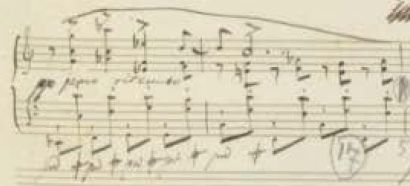Page 7 of 7
Re: tied quavers everywhere!
Posted: 03 Oct 2018, 22:28
by Schonbergian
At this point, I wonder if it's best if we bite the bullet and just use ten. everywhere when we want the full duration. Doesn't have the eloquence of a symbol but I've never seen it misinterpreted.
Re: tied quavers everywhere!
Posted: 04 Oct 2018, 06:52
by David Ward
I think a potential problem with that might be the way ‘ten’ over a note is often interpreted in Italian opera to mean hold it well beyond the written value.
I wonder whether or not we know definitively just what Verdi and maybe even more Puccini did mean by ‘ten.’
The held-for-ever high B at the end of Nessun dorma is a mere semiquaver (16th) with an accent (but no ‘ten’) over it which Puccini probably didn't expect to be held (or only very slightly on account of the marking poco allarg. - note the ‘poco’). The earliest recorded performances seem to have it short.
(I have edited this post somewhat since first posting.)
Re: tied quavers everywhere!
Posted: 04 Oct 2018, 07:13
by Anders Hedelin
No problem with that, Schonbergian! It seems difficult to create a new, simple and easily understood symbol that would be significantly more useful than the ten. Even if also the latter could be misunderstood.
John suggested the creation of a new symbol for a mild marcato, and going back to letting the dash signify tenuto. That seems even more difficult to me. Habits die hard.
To complicate things further, isn't the dash symbol quite often performed as a combination of a mild accent and a short tenuto? Especially when placed above a short note, or the beginning of a trill. A habit also quite hard to kill.
Re: tied quavers everywhere!
Posted: 04 Oct 2018, 14:09
by John Ruggero
A further complication is that one must take context into account to interpret all musical symbols, even the exact pitch of the notes themselves. This explains why, as David Ward points out, ten. can mean something different in an Italian opera and a Beethoven sonata, or as Anders Hedelin points out, the tenuto symbol can mean an accent + tenuto. And in Rachmaninoff's music, for example. — can be accent at times and a real tenuto at others. As well, a ten. might mean different things within a Beethoven sonata, depending on the situation. So every symbol has a range of meanings.
Since we already have a recognized symbol for tenuto, the use of the dash exclusively as a moderate accent, and ten. for a real tenuto has much to recommend it. The only problem is the cumbersome nature of the "ten." symbol when many are used, which caused earlier composers to use it mostly for single instances.
Re: tied quavers everywhere!
Posted: 06 Oct 2018, 16:57
by benwiggy
Or just teach people to hold notes for the written duration unless expressly indicated otherwise!
I have seen pencil markings of this kind: a horizontal arrow to the end of the note. (Given that we are generally talking about lengthier notes at the ends of phrases.) Though it's possible that this could be interpreted as some kind of accelerando....
Re: tied quavers everywhere!
Posted: 07 Oct 2018, 09:57
by Anders Hedelin
David Ward wrote: ↑26 Oct 2017, 20:42
Isn't it wonderful that musical notation is a living thing and open to interpretation?!
John Ruggero wrote: ↑04 Oct 2018, 14:09
A further complication is that one must take context into account to interpret all musical symbols...
If musical notation were as unambiguous as a fool-proof manual, some of us, at least, would be out of work. Or, work would be a bit dull.
Re: tied quavers everywhere!
Posted: 07 Oct 2018, 14:32
by John Ruggero
benwiggy wrote: ↑06 Oct 2018, 16:57
Or just teach people to hold notes for the written duration unless expressly indicated otherwise!
Anders Hedelin wrote: ↑07 Oct 2018, 09:57
If musical notation were as unambiguous as a fool-proof manual, some of us, at least, would be out of work. Or, work would be a bit dull.
As Anders implies, the length of a note also varies with context. In piano music, most are shorter or longer than written.
benwiggy wrote: ↑06 Oct 2018, 16:57
Though it's possible that this could be interpreted as some kind of accelerando....
It is used for forward motion toward a goal note, and the reverse for a pull-back.
Here is another candidate to specify full value.

- tenuto ties 2.jpeg (30.65 KiB) Viewed 6797 times
If the passage is slurred, the slur can be extended instead of the tie. Chopin actually used something like this repeatedly in the Etude op. 25 no. 4, so there is a precedent.

- Chopin Etude op 25 no 4 MS copy.jpeg (25.13 KiB) Viewed 6797 times